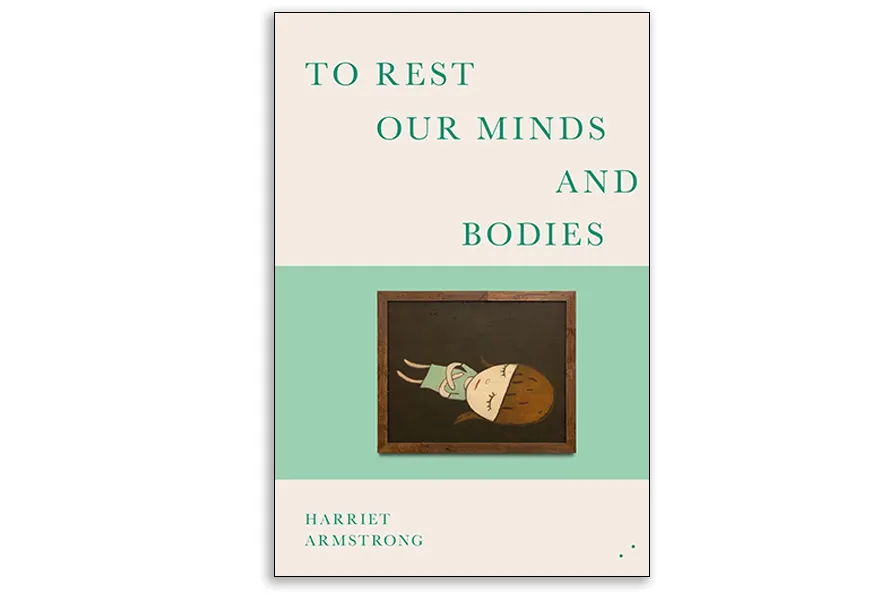FIONA O’CONNOR is fascinated by a novel written from the perspective of a neurodivergent psychology student who falls in love


To Rest Our Minds And Bodies
Harriet Armstrong, Les Fugitives London, £14.99
TO Rest Our Minds And Bodies is the debut novel by 24-year-old Harriet Armstrong. In it she mines the age-old territory of first love from a fascinating perspective: the protagonist is a neurodivergent psychology student entering her final year at college — “Really I was still a child then,” she admits.
The novel opens with the unnamed narrator floating in a holiday swimming pool like a baby in amniotic fluid. This baby is struggling with the mind/body conundrum: “I had become really conscious of ideas like the body and virginity and penetration and so I was hyperaware of the feeling of the water lapping at my body’s thresholds.”
In a first-person voice the protagonist tells us that she has dyspraxia and is possibly on the autism spectrum. This creates a writing sophisticated in its ideas but delivered plainly and simply in sentences that build out of somewhat unvaried blocks, like Lego, which the book mentions as though to reference its own method. “I could tell that Luke was older than me from the plainness of his Lego bricks. None of mine had ever been that plain.”
Luke is a master’s student the protagonist meets in her communal kitchen, and with whom she falls in love. So begins her painful progression to adult selfhood.
The coming-of-age novel has a long pedigree and Armstrong cites JD Salinger’s The Catcher in the Rye more than once through the book, perhaps hinting at the scope of her ambition — and why not? While there are similarities of alienation between the narrator and Salinger’s famous character, Holden Caulfield, it is in the sentence structures that comparison breaks down.
In this case, the narrator sees herself as a “disembodied, cerebral girl.” As self-absorbed as any 20-year-old worth her salt, when she begins to experience intense feelings she is torn between the imperative to categorise them and finding ways to express the overwhelming sense of being engulfed.
In fact, the relationship dynamic with Luke is a familiar power-play where the weaker player is kept in check, accommodated while useful, but never fully acknowledged. Luke tantalises her, keeps her around, uses her as a sounding board in his break-up with his girlfriend.
This dynamic allows Armstrong to show the reader the world through the eyes of a somewhat disassociated consciousness now tortured — a kind of adolescence on steroids — and this is deeply absorbing. With her character’s experiments with risky Tinder sex, her inability to be penetrable, her digressions on non-fungible tokens, Slavoj Zizek, and vaginal dilators, the writer estranges the world.
The novel aligns with contemporary writing such as Convenience Store Woman by Japanese author Sayaka Murata. Using the building blocks of simple statements, Armstrong conveys the otherness of objects in the world: “He started pushing himself onto my body and in that moment it suddenly seemed implausible that this was what sex was.”
There is an inconsistency in the sophistication of concepts cited — from anthropology and probability to Foucault’s panopticon — and the simplistic style which brings the narrator to us. The conceit can be overplayed.
But elsewhere the build-up of simple phrases makes for beautiful depictions of intimacy, such as Luke giving the narrator a haircut: “He slid two fingers around the hair so that the rest of his fingers were lightly grazing the top of my neck, the back of his hand brushing my cheekbone. I felt myself become wet and somehow that wasn’t embarrassing or even notable to me, and Luke was running his scissors through the piece of hair he was holding there and so much hair was falling onto my legs and Luke’s legs, too, inches of hair lying on top of us and around us, and Luke was separating out more and more sections of hair and holding them tenderly between his fingers and cutting right through them.”
And the ending of the novel is a tour de force in which the perspective of the devastated narrator is played out as a Sims video game and consciousness itself is destabilised.

FIONA O’CONNOR steps warily through a novel that skewers many of the exposed flanks of the over-privileged













